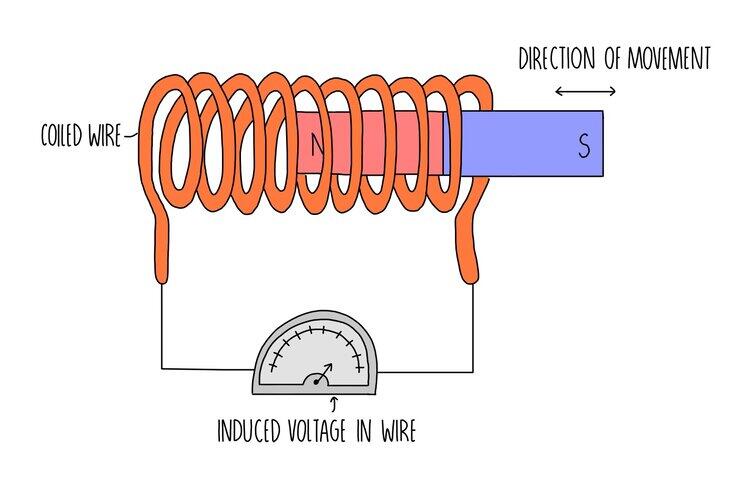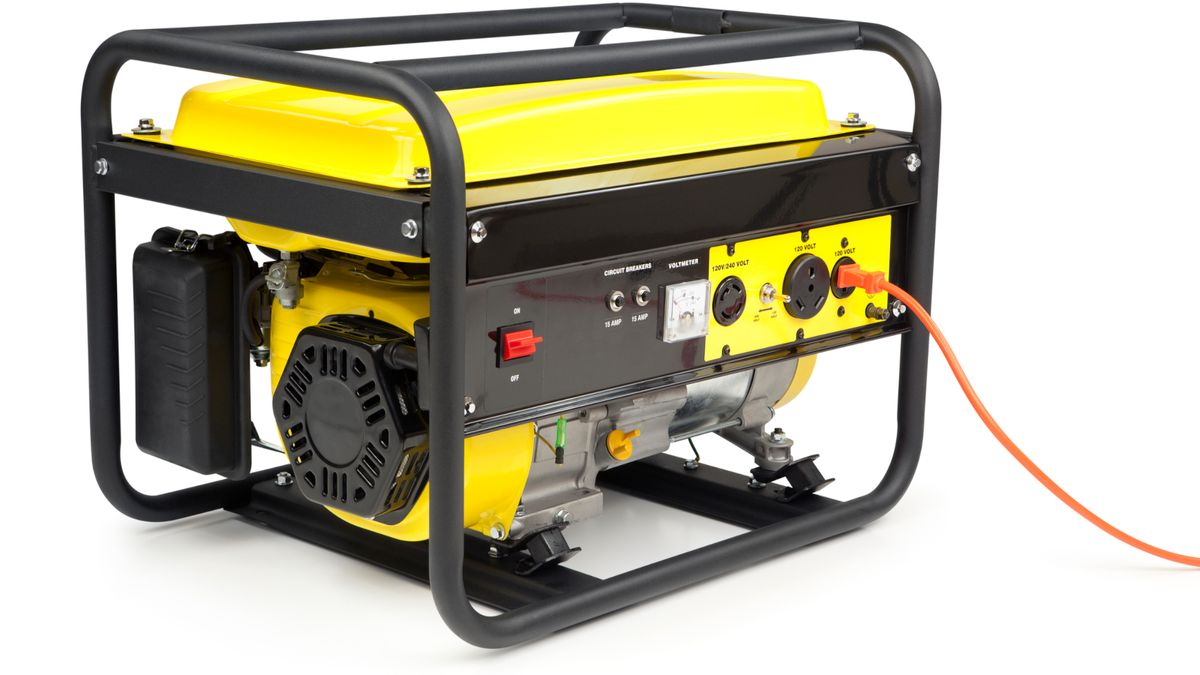Chapters
From illuminating our homes to fueling industries, electromagnetic induction and generators are integral to our daily lives. We can unravel the secrets behind electricity generation by comprehending Faraday's Law and the interplay of magnetic fields and conductors. This article delves into how electromagnetic induction is utilised in power generation and explores the fundamental principles that govern electrical generators.

Electromagnetic Induction
When a conductor or coil moves through a magnetic field, electromagnetic induction occurs. This means that a voltage is induced, resulting in current flow. Similarly, when a magnet moves through a coiled wire, the magnetic field change induces a voltage and current.

Several factors affect the magnitude of the induced voltage:
- Speed of movement: Faster movement of the conductor or coil through the magnetic field increases the induced voltage.
- Strength of the magnetic field: A stronger magnetic field leads to a larger induced voltage.
- Number and size of loops: More loops in the coiled wire or larger loop size contribute to a greater induced voltage.
According to Michael Faraday's Law of electromagnetic induction, the induced voltage is directly proportional to the rate at which the magnetic field lines are cut. This means that no voltage or current is generated if a wire remains stationary or moves parallel to the field lines. Current is produced only when the wire moves perpendicular to the magnetic field.
How is electromagnetic induction used in power generation?
Electromagnetic induction is the fundamental principle behind power generation in various power plants. Here are two commonly used methods:
1. Faraday's Law and Alternating Current (AC) Generators
Faraday's Law states that the magnitude of the induced EMF is directly proportional to the rate of change of magnetic flux. AC generators, also known as alternators, utilise this principle to generate alternating current.
In an AC generator, a rotor equipped with magnets or electromagnets is rotated within a stationary coil of wire called the stator. As the rotor spins, the changing magnetic field induces an alternating voltage across the coil. This induced voltage is harnessed as electrical power, which is subsequently distributed through power grids for various applications.
2. Direct Current (DC) Generators
DC generators operate on the same principle of electromagnetic induction but utilise a commutator and brushes to convert the induced AC voltage into direct current. The commutator ensures that the current direction in the external circuit remains constant.
DC generators find applications in devices that require a steady, unidirectional flow of current, such as batteries and some electronic circuits.
Significance and Advantages of Electromagnetic Induction in Power Generation
Some of the advantages of using electromagnetic induction in power generation are given below:
1. Renewable Energy Sources
One of the significant advantages of electromagnetic induction is its ability to harness renewable energy sources. Renewable energy, such as wind and hydroelectric power, uses mechanical energy to generate electricity. Electromagnetic induction makes it possible to convert this mechanical energy into electrical energy, which can be fed into the power grid for various applications.
For example, in wind turbines, the rotation of the blades spins a rotor equipped with magnets inside a stator, inducing an electrical current through electromagnetic induction. This clean and sustainable method of power generation reduces our dependence on fossil fuels, promotes environmental sustainability, and helps combat climate change.
2. Efficient Power Transmission
Electromagnetic induction, mainly alternating current (AC) generators, allows for efficient power transmission over long distances. AC generators produce alternating current, which can be easily transformed using transformers for high-voltage transmission.
High-voltage transmission is advantageous because it reduces power losses that occur during transmission. Power companies can minimise resistive losses by transmitting electricity at high voltages, ensuring that a significant amount of electrical energy reaches consumers without dissipating heat. This efficient power transmission is crucial for delivering electricity to homes, businesses, and industries over extensive power grids.
3. Versatile Applications
Electromagnetic induction has paved the way for various electrical devices and technologies that power our modern world. The principles of electromagnetic induction are fundamental to the functioning of various devices, including:
a. Motors: Electric motors utilise electromagnetic induction to convert electrical energy into mechanical energy. This principle is vital for various applications, from powering household appliances to driving industrial machinery and transportation systems.
b. Transformers: Transformers use electromagnetic induction to transfer electrical energy between different voltage levels. They are essential in stepping up voltage for efficient long-distance transmission and stepping down voltage for safe use in homes and industries.
c. Alternators: Alternators, which are AC generators, form the backbone of electricity generation in power plants. These generators produce alternating current through electromagnetic induction, providing the bulk of the electricity that powers our daily lives.
d. Induction Cookers: Induction cookers utilise electromagnetic induction to heat cookware directly, offering faster and more efficient cooking than traditional methods.
e. Magnetic Resonance Imaging (MRI): Medical imaging technology like MRI uses strong magnetic fields generated through electromagnetic induction to produce detailed images of the human body, aiding in diagnostics and medical research.
The principles of electromagnetic induction are deeply ingrained in the functioning of numerous electrical devices and technologies, contributing to advancements in various industries and improving our quality of life.
Principles of Electric Generators
Electric generators are devices that convert mechanical energy into electrical energy through the principles of electromagnetic induction. Let's explore these principles in detail:
- Electromagnetic Induction: The fundamental principle underlying electric generators is electromagnetic induction. Electromagnetic induction occurs when a conductor (usually a coil of wire) is exposed to a changing magnetic field, producing an electromotive force (EMF) or voltage across the conductor. This EMF is responsible for generating the electrical current in the generator.
- Faraday's Law of Electromagnetic Induction: Faraday's Law states that the magnitude of the induced EMF is directly proportional to the rate of change of magnetic flux. Magnetic flux refers to the amount of magnetic field passing through a given area. When the magnetic field through a conductor changes or when the conductor moves through a magnetic field, the magnetic flux changes, leading to the induction of an EMF.

Components of an Electric Generator
Electric generators consist of several essential components that work together to produce electricity:
- Rotor: The rotor is the rotating part of the generator. It typically consists of a coil of wire wound around an iron core. An external mechanical force, such as a turbine in a power plant or an engine in a portable generator can turn the rotor.
- Stator: The stator is the stationary part of the generator that surrounds the rotor. It contains a set of wire coils arranged in a specific configuration. These coils are connected to an external circuit to deliver the generated electricity.
- Magnetic Field: A magnetic field is necessary for electromagnetic induction to occur. In some generators, a permanent magnet creates a steady magnetic field. In contrast, in others, an electromagnet is employed, which produces a magnetic field when an electric current passes through it.
- Slip Rings and Brushes: In some generators, the rotor is equipped with slip rings and brushes. Slip rings are conductive rings that rotate with the rotor, while brushes (typically made of carbon) remain stationary and make contact with the slip rings. The slip rings, and brushes allow the generated electricity to be collected from the rotor and transferred to an external circuit.
How Electric Generators Work?
- When the rotor of an electric generator is turned, the magnetic field within the generator changes.
- This changing magnetic field induces an EMF in the coils of the stator through electromagnetic induction, according to Faraday's Law.
- The induced EMF creates a potential difference, causing an electric current to flow in the external circuit connected to the generator.
- As the rotor rotates, the magnetic field alternates or changes direction, resulting in an alternating current (AC) generator.
- In some cases, a commutator and brushes can be used to convert the alternating current into direct current (DC) by changing the direction of the current flow.













You are the best,, coz you have gotten content about the topics
Hello ! Glad to hear that you’ve found the content useful!